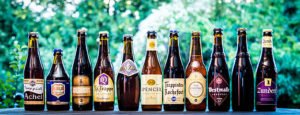I am not a huge fan of brew or breweries, but I like a good dark beer. I’m the guy ordering Guinness stout on tap.
One of the wine shops in the nearby town also sells craft beers, and that interested me, for that one night in 10 I feel like a beer would be a good idea.
As a Christmas gift I got a sampler of six dark, bottled beers, and I picked out something called Trappistes Rochefort, popped the cap … and about two pulls later I announced, “There’s something different about this beer.”
I took a closer look at the labels on the bottle and soon found the difference:
My Trappistes Rochefort beer (fourth from left, above) was 11.3 percent alcohol by volume, a ratio that would have made it one of the most alcoholic beers in the world a few decades ago.
If we stipulate that most beers have an alcohol content of from 4 to 6 percent, the beer I was holding was an outlier — though not as much as it would have been 30 years ago, when it would have rivaled the world’s most potent beers. (Over the past few decades, several brewers have tinkered with the process so that 20 percent alcohol and even 40 percent beers can be had — if you don’t mind a bit of malt and hops with your alcohol.)
As for the Trappist beer … it’s a thing. I had gone down a rabbit hole, and I have climbed back out with information — though the beer-savvy certainly will already know about this.
The Trappists are an order of monks known as Cistercians who commit themselves to prayer, reading and manual labor.
In 11 of these monasteries, including the one at Rochefort, Belgium, the monks also make beer that is sold to the public, with profits going to support the monastery or given to charities.
The Trappists seem to prefer strong, dark beers.
In my gift set of six dark beers, I had another Trappist beer, one called Westmalle (also from Belgium), and it was no watery little thing, either, but at 8 percent alcohol content it trails the Rochefort guys by a fair distance.
The Rochefort Abbey was hit by a fire in 2010, and there were fears among Trappist fans that beer production would be interrupted. It was not, the BBC reported, noting that Trappist beer “is seen as a gold standard for connoisseurs of the drink.” Perhaps because the monks there have been brewing it since the 16th century and have settled on a process they prefer.
So, Trappist beers. Not for anyone who plans to have two or three beers in a sitting, because the alcohol is going to do some damage.
Now I know.


1 response so far ↓
1 Paul Larson // Jan 9, 2017 at 9:06 PM
Hello,
Elaina passed along your post about Trappist beers. By the way, whatever happened to John Q. Trapp?
Anyway, I cannot speak about Trappist beers, but I do like the malt and a good stout, okay specifically Double imperial stouts.
The next time you are in town/ state/ country, I will gladly pour you a beer from The Bruery which is based in Placentia.
Black Tuesday is an Imperial Stout aged in Bourbon Barrels for over a year and the 2016 vintage weighs in at 20.2% abv.
They added hazelnuts to the Black Tuesday in Bourbon Barrels to create Grey Monday though it is only 19.5% abv.
They added vanilla beans and chocolate from TCHO in S.F. to the Black Tuesday in Bourbon Barrels to create Chocolate Rain (now, now). Depending on the vintage, the abv is anywhere between 18% – 19.5%
I think these beers are absolutely delicious yet I agree you should only have a glass unless you want to go Night Night immediately.
Come to think of it, I gave Dan a bottle of Black Tuesday for
Hanukkah but haven’t heard from him since. Uh oh.
Take care,
Paul Larson
Leave a Comment